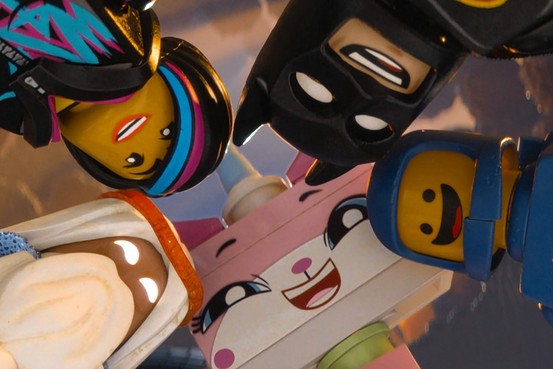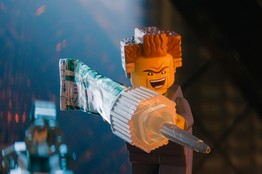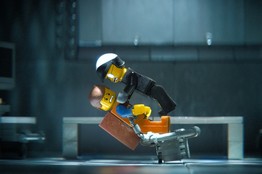
BUILDING ‘THE LEGO MOVIE,’ ONE BRICK AT A TIME
By DON STEINBERG Jan. 30, 2014 11:48 a.m. ET “The Lego Movie” explores what may be the essential question of Lego building as it applies to life: Must you dutifully follow the instructions, or can you combine pieces creatively to make anything you dream up? In the animated children’s comedy, a repressive overlord (voiced by Will Ferrell) is so maniacal about controlling the residents of Bricksburg that he has a weapon designed to glue all the pieces of their world together, putting an end to freestyle play. Only a band of wisecracking rebels (including Chris Pratt, Elizabeth Banks, Will Arnett and Morgan Freeman) can stop him. The film is computer-animated but made to look as if all the scenery is built out of real Lego pieces. Everything moves in a way that simulates the stop-motion films that thousands of Lego customers have created with their pieces and posted online.
“The Lego Movie” explores what may be the essential question of Lego building as it applies to life: Must you dutifully follow the instructions, or can you combine pieces creatively to make anything you dream up? In the animated children’s comedy, a repressive overlord (voiced by Will Ferrell) is so maniacal about controlling the residents of Bricksburg that he has a weapon designed to glue all the pieces of their world together, putting an end to freestyle play. Only a band of wisecracking rebels (including Chris Pratt, Elizabeth Banks, Will Arnett and Morgan Freeman) can stop him. The film is computer-animated but made to look as if all the scenery is built out of real Lego pieces. Everything moves in a way that simulates the stop-motion films that thousands of Lego customers have created with their pieces and posted online.
“Any frame, if you stopped the movie, would be something you could recreate if you had a lot of money to buy a lot of Lego bricks,” says co-director Christopher Miller.
Maybe just as interesting, if less candy-colored, is the story of how “The Lego Movie” came to be. Lego’s pervasiveness is no secret: The company estimates that the world’s children spend 5 billion hours a year playing with its toys and that, on average, every person on Earth owns 86 Lego bricks (many parents whose homes are littered with Lego pieces will acknowledge the allocation is wildly uneven.) The film, which opens Feb. 7 as the first Lego-related theatrical release, will show whether Lego can emerge from the shadow of Disney, Universal and Warner Bros. as a toy force in Hollywood.
Lego’s collaboration with Hollywood dates back to 1998, when the company, until then known for generic play sets like “Lego Castle,” made a deal with Lucasfilm to create sets based on “Star Wars.” It was a departure for the Danish company and seen as risky at the time. In a world of relentless marketing aimed at children, many parents had come to see Lego as a haven from commercialism. And Lego had never before “seen the need to tell other people’s stories in Lego form,” says Jill Wilfert, the company’s vice president of licensing and entertainment. “Even though there was a huge ‘Star Wars’ movie coming out [“Episode 1: The Phantom Menace”], it was not a decision we took lightly.”
 The sets became a top seller, and Lego went back for more. In 2000, the company released the Lego Studios Steven Spielberg Moviemaker set, which included a digital camera, software and parts to recreate a scene from “The Lost World: Jurassic Park.” (Fan-made Lego movies can be seen online on sites such as brickfilms.com.) Soon customers could buy Legos based on Harry Potter, Indiana Jones,“Lord of the Rings” “The Hobbit,” and superheroes from both the DC and Marvel comic universes.
The sets became a top seller, and Lego went back for more. In 2000, the company released the Lego Studios Steven Spielberg Moviemaker set, which included a digital camera, software and parts to recreate a scene from “The Lost World: Jurassic Park.” (Fan-made Lego movies can be seen online on sites such as brickfilms.com.) Soon customers could buy Legos based on Harry Potter, Indiana Jones,“Lord of the Rings” “The Hobbit,” and superheroes from both the DC and Marvel comic universes.
Separately, Hollywood was getting excited about old toys. “Transformers,” based on Hasbro robots, grossed $710 million world-wide for Paramount and DreamWorks in 2007, and studios clamored over classic toy properties like Battleship and G.I. Joe. Lego seemed a natural—it had already been releasing short movies featuring its characters on home video—and Warner Bros. had an inside track. In addition to controlling many of the Legofied movie franchises, Warner owns TT Games, which was developing Lego videogames (about 85 million games have been sold).
 In 2009, Warner producer Dan Lin and writers Dan and Kevin Hageman traveled to Lego headquarters in Billund, Denmark, to pitch a movie set in a Lego-brick universe. Although Lego had financial trouble in 2004 (its near-bankruptcy became a business-school case study), by then it was growing 20% to 25% a year, doing just fine without a movie. (The company last year passed Hasbro in global sales to become the world’s No. 2 toy maker.)
In 2009, Warner producer Dan Lin and writers Dan and Kevin Hageman traveled to Lego headquarters in Billund, Denmark, to pitch a movie set in a Lego-brick universe. Although Lego had financial trouble in 2004 (its near-bankruptcy became a business-school case study), by then it was growing 20% to 25% a year, doing just fine without a movie. (The company last year passed Hasbro in global sales to become the world’s No. 2 toy maker.)
“They really looked at me and said ‘what’s in it for us?’,” Mr. Lin recalls.
Among other things, they talked about making Lego feel cooler to older kids.
“Five to 12 is their sweet spot,” Mr. Lin says. “After that is what Lego calls ‘the dark ages,’ when kids grow out of Lego and it’s not cool. Part of the appeal is that a movie, if done right, can appeal to all audiences.”
Lego is receiving a share of the film’s profits and flexing its own marketing muscle to promote it. “They’re opening a whole new exhibit at LegoLand Carlsbad [in California] to promote the movie,” Mr. Lin says. “It’s in all their stores. They have Lego Club Magazine. They’re promoting it online, on every single level that a studio normally couldn’t hit.” In addition, Lego isn’t putting just one product on the line with this film: “It’s the main brand. It impacts every one of their toy lines. It’s a bigger risk.”
Warner brought in co-directors Phil Lord and Christopher Miller, who had made “Cloudy with a Chance of Meatballs,” to flesh out characters and a plot for the movie, which the studio is calling “family-friendly with an edge.”
“Our fear going into it,” Mr. Miller says, “was they were going to say, ‘We wanna sell this toy and this toy. Kids love race cars, so we need to have a race car in the movie.’ They never did anything like that. They said make the movie you want make. We’ll make toys based on that.”
The company has done that. Already in stores are some of the 17 new building sets that recreate scenes from “The Lego Movie” and 16 new character figurines, known as “minifigs.” There will be a simultaneous Feb. 7 release of The Lego Movie Videogame, McDonald’s Happy Meal collectible cups, and all the other usual tie-in merchandise licensed to outside partners: books, apparel, school supplies.
The movie strives to avoid playing like a giant commercial. “One of the things we talked about from the beginning is to treat Lego as a medium more than a product,” Mr. Lord says. Because the conceit is that anything in the movie could be constructed using real Legos, the filmmakers and their animation studio in Australia collaborated with Lego engineers in Denmark. Animators in some cases used Lego Digital Designer software, which anyone can download, to prototype space ships or pirate ships. “Once we got it pretty close we would send it over to Denmark, where the Lego designers who are really experts at making things structurally sound would adjust it,” Mr. Miller says.
“The Lego Movie” gathers characters who don’t normally hang around together, coming from separately owned franchises and studios. These include Warner movie characters like Batman, Superman, Gandalf, Dumbledore and a Teenage Mutant Ninja Turtle; but also Han Solo, Shaquille O’Neal (from a 2003 NBA-licensed Lego set), and Milhouse from “The Simpsons” (Lego is releasing “Simpsons” products in February). Such matchups can be a licensing nightmare, but Mr. Lin says Lego helped bring the non-Warner characters into the film.
Lego’s experience creating videogames helped the filmmakers gauge what would be acceptable to parents in this first theatrical release. One rule the movie follows, Mr. Lin says: “Lego minifigures can’t kiss. Parents don’t want to see Lego minifigures kiss.”
_White.png)